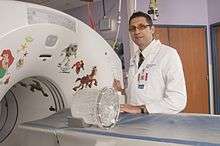Jaszczak phantom
A Jaszczak phantom (pronounced "Jay-zak") aka Data Spectrum ECT phantom[1] is an imaging phantom used for validating scanner geometry, 3D contrast, uniformity, resolution, attenuation and scatter correction or alignment tasks in nuclear medicine. It is commonly used in academic centers and hospitals to characterize a SPECT or a Positron Emission Tomography (PET) system for quality control purposes. It is used for accreditation by clinical and academic facilities for the American College of Radiology.[2][3]

The phantom was developed by Ronald J. Jaszczak[4] of Duke University,[5] and was filed for a patent in 1982.[6] It is a cylinder containing fillable inserts that is often used with a radionuclide such as Technetium-99m[7] or Fluorine-18.[8]
Although the phantom can be used for acceptance testing, the National Electrical Manufacturers Association recommends a 30 million count acquisition and section reconstruction of the phantom be performed quarterly.[9]
Structure and composition
Jaszczak phantoms consist of a main cylinder or tank made of acrylic plastic with several inserts. The circular phantom comes in two varieties: flanged and flangeless. The latter is recommended by the American College of Radiology for accreditation of nuclear medicine departments.[10] All Jaszczak phantoms have six solid spheres and six sets of 'cold' rods. In flanged models, the sizes of the spheres vary. The number of rods in each set depends on the size of the rod in that set as different models of the phantom have rods of different sizes. In flangeless models, the diameters of the spheres are 9.5, 12.7, 15.9, 19.1, 25.4 and 31.8 mm, while the rod diameters are 4.8, 6.4, 7.9, 9.5, 11.1 and 12.7 mm. Both solid spheres and rod inserts mimic cold lesions in a hot background. Spheres are used to measure the image contrast while the rods are used to investigate the image resolution in SPECT systems.[11]
References
- Quality assurance for SPECT systems. IAEA Health Series No. 6. 2009. International Atomic Energy Agency publications. ISBN 978-92-0-103709-1 p.182
- http://tech.snmjournals.org/content/34/1/18.full
- http://www.acraccreditation.org/~/media/Documents/NucMed-PET/Nuclear-Medicine-Requirements.pdf?la=en
- Jennifer Prekeges. Nuclear Medicine Instrumentation. Jones & Bartlett Publishers. 2012. ISBN 1449645372 p.189
- https://snmmi.eventsential.org/Speakers/Details/25113
- https://www.google.com/patents/US4499375
- Mattsson S, Hoeschen C. Radiation Protection in Nuclear Medicine. Springer. 2003. ISBN 978-3-642-31166-6. p.82
- Waterstram-Rich KM, Christian PE. Nuclear Medicine and PET/CT. 7th Ed. Elsevier Health Sciences, 2013. ISBN 0323277047 p.345
- Bolus NE, Brady AB. Steves' Review of Nuclear Medicine Technology. Society of Nuclear Medicine. 4th Ed. 2011. ISBN 978-0-932004-87-1 p.177
- http://www.acraccreditation.org/~/media/Documents/NucMed-PET/Nuclear-Medicine-Requirements.pdf?la=en
- Bailey DL, Humm JL, et al. Nuclear Medicine Physics: A Handbook for Teachers and Students. 2014. International Atomic Energy Agency publications. ISBN 978-92-0-143810-2. p.563